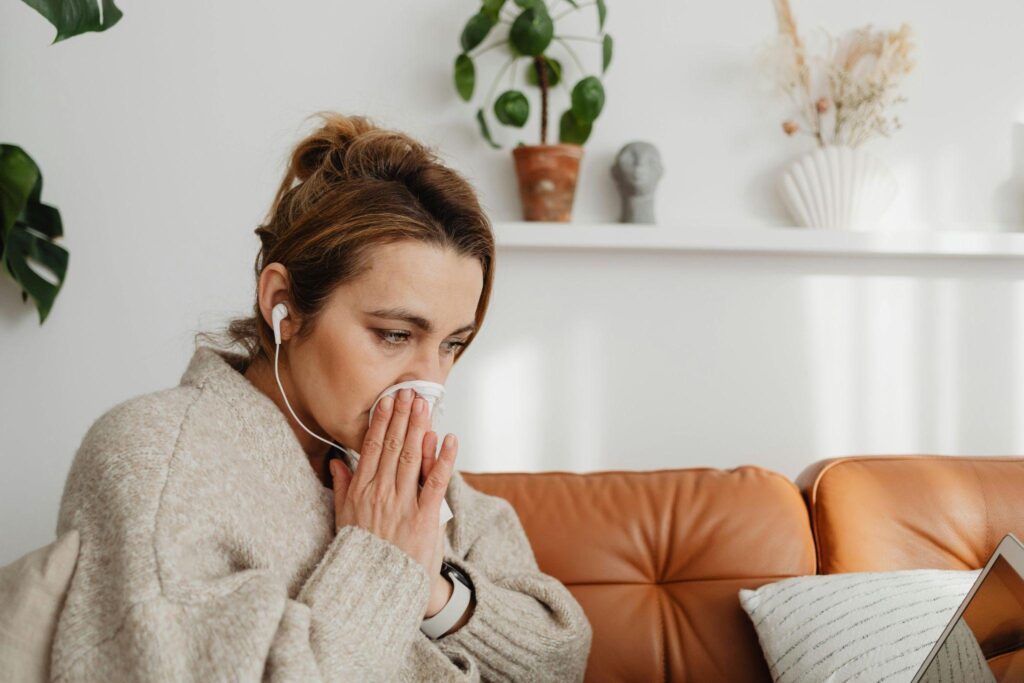Winter brings shorter days, colder temperatures, and more time spent indoors. These seasonal changes create conditions that support the spread of respiratory and gastrointestinal infections.
While illness is never fully avoidable, understanding why sickness rises during winter and how the immune system responds allows people to make informed choices that support health. An approach to prevention focuses on small daily habits and environmental awareness rather than drastic changes.
Why Winter Increases Illness Risk
Cold weather alone does not cause illness, but it creates an environment where infections spread more easily. Several seasonal factors combine to increase risk:
- People spend more time indoors with limited airflow.
- Windows remain closed, allowing viruses to build up inside shared spaces.
- Heating systems dry the air, reducing moisture in the nose and throat.
- Schools and workplaces bring large groups together during peak transmission periods.
- Stress from holidays, travel, exams, and workload can reduce healthy routines.
Low humidity is a major contributor. When indoor air lacks moisture, respiratory droplets remain airborne longer. At the same time, the lining of the nose and throat becomes drier and less effective at trapping viruses. Frequent holiday gatherings and winter travel further increase exposure to different pathogens.
Another seasonal factor is reduced sunlight. Sunlight supports vitamin D production, and vitamin D plays a documented part in immune function. Limited daylight during winter lowers natural vitamin D levels for many people, which may contribute to higher infection rates.
Winter does not create viruses, but it creates conditions that help them persist and spread quickly. Understanding these conditions helps people adjust daily routines during months when infection risk is highest.
Learn more about keeping indoor air and surfaces germ-free in our dedicated blog on the topic .
How the Immune System Defends the Body

The immune system uses multiple layers of defense to protect the body from viruses and bacteria year-round. These defenses need steady support from daily habits.
Major components of immune defense include:
- Physical barriers,such as skin and mucus, that block pathogens.
- The innate immune response, which reacts immediately when a pathogen enters the body.
- The adaptive immune response, which recognizes specific pathogens and builds long-term protection.
- Inflammation, which brings immune cells to the infection site to limit the spread.
- Antibodies, which attach to pathogens and prevent them from infecting healthy cells.
For the immune system to function well, it requires regular sleep, balanced nutrition, hydration, physical movement, and stress management. These habits help regulate inflammation, support antibody production, and maintain tissues that act as barriers.
When lifestyle patterns change, such as reduced sleep, high stress, skipped meals, or dehydration, the immune system becomes less responsive. This does not mean it stops working, but it reacts more slowly and allows infections to take hold more easily.
Understanding these processes helps explain why consistent routines support protection during high-risk months.
Most Common Winter Illnesses and How They Spread
Winter is linked to a sharp rise in respiratory infections and gastrointestinal viruses.
Although each illness has different symptoms, they spread through similar pathways: breathing in infected droplets, touching contaminated surfaces, or sharing food and beverages.
Understanding how these illnesses behave helps people spot early signs and take precautions.
Flu (Influenza)
The flu spreads rapidly through droplets released when an infected person coughs, sneezes, talks, or even breathes. Indoor winter environments make transmission easier because people gather closely and ventilation is limited.
Common symptoms include:
- Fever and chills
- Tiredness and weakness
- Coughing and sore throat
- Muscle and body aches
- Headache
Additional notes:
- People can spread the flu before symptoms appear, which increases outbreaks during colder months.
- High transmission settings include schools, workplaces, public transportation, dormitories, and family gatherings.
- Annual flu vaccination reduces the risk of severe illness and complications.
RSV (Respiratory Syncytial Virus)
RSV spreads through close physical contact and surfaces touched by infected individuals, such as toys, tables, bedding, and doorknobs. While anyone can contract RSV, infants, toddlers, older adults, and individuals with respiratory conditions face a higher risk of complications.
Common symptoms include:
- Cough and congestion
- Mild to high fever
- Wheezing or shortness of breath
- Reduced appetite in children
Additional notes:
- RSV peaks in the winter and early spring.
- In high-risk groups, RSV may lead to pneumonia or bronchiolitis.
- Good hygiene and avoiding close contact with sick individuals help reduce the spread.
Strep Throat
Strep throat is caused by Streptococcus pyogenes bacteria and spreads through respiratory droplets shared in crowded indoor spaces such as classrooms and dormitories.
Common symptoms include:
- Sudden and severe sore throat
- Fever
- Swollen tonsils, often with white patches
- Pain when swallowing
Additional notes:
- Unlike viral infections, strep throat usually does not cause a runny nose or cough.
- A medical diagnosis is needed for proper treatment, usually antibiotics.
- Untreated strep throat can lead to complications such as rheumatic fever.
Sinus Infections
Sinus infections occur when viruses or bacteria irritate the sinus lining, causing inflammation and blockage. Cold winter air and low humidity dry out the nasal passages, making infection more likely.
Common symptoms include:
- Pressure around the forehead, cheeks, or eyes
- Nasal congestion
- Thick mucus or postnasal drip
- Headaches and a reduced sense of smell
Additional notes:
- Most sinus infections are viral and improve gradually without antibiotics.
- Bacterial infections may require medical support.
- Steam inhalation, hydration, and humidifiers can support comfort during recovery.
Stomach Viruses / Norovirus
Stomach viruses spread quickly through contaminated food, surfaces, or contact with an infected person. Norovirus is the most common cause of viral gastroenteritis and thrives in crowded indoor environments.
Common symptoms include:
- Vomiting and nausea
- Diarrhea
- Stomach pain or cramping
- Dehydration
Additional notes:
- Outbreaks frequently occur in schools, hotels, cruise ships, dorms, and nursing homes.
- The virus remains contagious even after symptoms start to improve.
- Cleaning shared surfaces and washing hands before eating are important preventive habits.
Common Cold
The common cold is caused by multiple viruses, most frequently rhinoviruses. Transmission occurs through airborne droplets and contaminated hands touching the nose, mouth, or eyes.
Common symptoms include:
- Runny or congested nose
- Mild cough
- Sore throat
- Tiredness or low energy
Additional notes:
- Colds are usually mild but spread fast because people often continue daily routines while contagious.
- Symptoms generally improve within 7–10 days.
- Frequent handwashing and resting at the first sign of illness help reduce transmission.
Lifestyle Habits That Lower Infection Risk

Daily routines influence the body’s ability to defend against viruses and bacteria. When healthy habits remain consistent, the immune system responds more quickly and recovers more easily.
Nutrition and immune support
Food provides the building blocks the immune system needs to produce antibodies and protective cells. Diets low in vitamins, minerals, and protein can weaken immune response over time. Winter requires attention to nourishment because appetite and hydration often decrease in cold weather. Including fruits, vegetables, lean proteins, whole grains, and healthy fats supports energy and immune function.
Regular movement and circulation
Physical activity helps move immune cells throughout the body. Even light exercise supports circulation, improves respiratory function, and maintains muscle strength. Long periods of sitting lower immune activity, especially during winter when people spend more time indoors. Short walks, stretching, and moderate workouts are enough to maintain consistency.
Consistent sleep and recovery
Sleep allows the immune system to repair tissues and regulate inflammation. When sleep patterns shift due to late nights, stress, or long work periods, the body becomes more susceptible to infections. Sleeping 7–9 hours on a regular schedule gives the immune system time to reset.
Stress management and mental health
Chronic stress increases cortisol, a hormone that suppresses immune activity. Stress also contributes to irregular sleep and appetite, which further weakens immunity. Helpful habits include time outdoors, brief rest periods during busy days, light exercise, and calming social activities.
Hydration patterns
Hydration keeps the mucus membranes in the nose and throat moist. These tissues trap viruses and prevent them from entering the body. Dehydration—common during cold months—dries these protective barriers and increases the risk of respiratory infections. Drinking water regularly, even without thirst, supports immune strength.
Strong immunity does not rely on extreme changes. Simple, steady routines allow the body to maintain a stable defense system throughout winter.
Hygiene Habits That Matter More Than People Realize

Hygiene limits exposure to viruses and bacteria before they reach the immune system. While these habits appear simple, they reduce illness more than many people expect, especially during winter.
Hand hygiene
- Wash your hands before eating and after returning home
- Use soap and water for at least 20 seconds
- Use hand sanitizer when sinks are not available
Cleaning phones, keyboards, and remote controls
- Electronic devices carry respiratory viruses because people touch their faces after using them
- Wipe devices weekly with disinfecting cloths
- Avoid using phones while eating
Food safety and shared kitchen behaviors
- Do not leave food uncovered in shared refrigerators
- Clean counters and tables before and after preparing meals
- Use separate utensils for raw meat and cooked foods
- Keep sponges and cloths clean and replace them regularly
Masks during active symptoms
- Wearing a mask while sick reduces the spread of respiratory droplets in shared spaces
- This applies in homes, workplaces, schools, and dorms
- Masks protect others during the contagious period, even before full symptoms develop
Avoiding sharing cups, bottles, makeup, and linens
- Personal-use items transfer saliva, skin cells, and viruses
- Sharing increases the risk of respiratory and stomach infections
- Labeling personal items in shared living spaces prevents mix-ups
Small hygiene steps reduce the viral load in the spaces people live and work in. These changes do not remove all infection risk, but they reduce daily exposure and allow the immune system to work under less strain during winter.
Air Quality and Ventilation in Winter

Air quality shapes how easily respiratory viruses spread indoors. Winter increases risk because windows stay closed, heaters run constantly, and people spend more time in confined spaces.
Why does indoor air hold viruses longer?
Respiratory viruses spread through droplets and aerosols released when people breathe, speak, cough, or sneeze. Poor ventilation allows these particles to stay suspended in the air instead of dispersing. Without airflow, shared indoor spaces accumulate higher concentrations of airborne viruses.
Humidity balance
Viruses survive longer in dry air. Heating systems reduce indoor humidity, which dries the nose and throat. When these tissues lose moisture, they become less effective at filtering out viruses. Maintaining moderate indoor humidity helps support the body’s natural barrier system.
Simple ways to improve airflow at home, dorms, or offices
- Open windows for short intervals, even during cold weather
- Let sunlight into rooms when possible
- Use fans to circulate air rather than raise heat
- Use humidifiers during winter to prevent extremely dry air
- Avoid blocking air vents and keep filters clean
Improving air quality helps reduce the concentration of viruses circulating in indoor environments. When paired with healthy routines and hygiene habits, ventilation becomes an important part of winter illness prevention in homes, shared housing, and workplaces
Vaccine Recommendations for Seasonal Protection
Vaccines reduce the risk of severe illness, hospitalization, and complications from several common winter infections. They do not guarantee complete protection from infection, but they strengthen the immune response so the body can defend itself more effectively.
Flu
The flu virus changes frequently, which is why the flu vaccine is updated each year. Annual vaccination helps the body recognize circulating strains more quickly. Vaccination is generally recommended before peak flu activity begins in late fall.
RSV for older adults and infants
RSV vaccines and preventive injections are available for specific groups. RSV can lead to severe lung infections in infants, toddlers, older adults, and individuals with chronic respiratory or heart conditions. Preventive options can help lower the risk of complications during peak RSV months.
Pneumococcal vaccines for eligible groups
Pneumococcal infections can cause pneumonia, bloodstream infections, and meningitis. Vaccines are available for adults over a certain age and individuals with specific chronic health conditions. These vaccines support protection when the immune system naturally becomes more reactive during winter.
Why timing matters
Vaccines take time to activate the immune system. Receiving recommended vaccines before peak winter circulation gives the body the preparation it needs to respond more quickly. Health professionals often advise scheduling vaccines in early fall to allow the immune response to build before widespread seasonal transmission begins.
Vaccination remains one of several prevention tools, alongside hygiene, hydration, ventilation, nutrition, and rest.
Read more about vaccines and boosters in our dedicated blog on the topic.
When to Stay Home and Why It Protects Others

Staying home while sick protects individual recovery and lowers transmission to others. Many common illnesses can spread before symptoms appear, but contagiousness usually rises during the first few days of coughing, sneezing, fever, or stomach symptoms.
Contagious periods of common illnesses
- Flu is most contagious in the first 3–4 days after symptoms start
- RSV spreads heavily while coughing and wheezing continue
- Strep throat remains contagious until antibiotics have been taken for 24 hours
- Norovirus spreads rapidly during vomiting and diarrhea and continues through early recovery
- Colds are contagious from onset through the first 5–7 days
Resting at the first sign of illness helps the immune system respond earlier. When people continue daily activities while sick, symptoms may last longer and spread to classmates, coworkers, and household members.
Choosing to stay home protects:
- Children and older adults with weaker immunity
- People with chronic health conditions
- Pregnant individuals
- Workplaces, schools, and dorms with shared air and surfaces
A short period of rest often prevents long recovery times and broader outbreaks. Returning to work or school only when symptoms improve supports both personal well-being and public health.
Supporting Children, Older Adults, and Immunocompromised Family Members

Certain groups are more likely to develop severe illness from viruses and bacteria. Children, older adults, and immunocompromised individuals often have immune systems that react more slowly or less aggressively to infection.
Why are these groups more susceptible?
- Children encounter new viruses frequently while their immune systems are still developing
- Older adults experience a natural immune slowdown and chronic health conditions more often
- Immunocompromised individuals may produce fewer antibodies or take medications that limit immune activity
Practical prevention steps at home
- Wash your hands before meals and after returning home
- Clean shared surfaces such as doorknobs, faucets, remotes, and light switches
- Use separate towels and water bottles
- Improve indoor airflow when guests visit
- Keep high-touch toys and devices wiped regularly
Communication and shared routines reduce the spread
- Set clear expectations about staying home when sick
- Encourage open conversation about symptoms without judgment
- Plan indoor visits around health status and seasonal infection peaks
- Teach children how to cover coughs, use tissues, and avoid sharing drinks
Families do not need strict rules to reduce risk. Consistent and supportive routines create safer environments for those who are more vulnerable.
Workplace and School Habits That Reduce Sick Days

Shared environments such as offices, classrooms, and dormitories increase exposure to infectious droplets and surfaces. Small adjustments during high-risk months help reduce the circulation of viruses and bacteria.
Adjusting routines during peak illness months
- Open windows for airflow when possible
- Schedule outdoor activities or meetings when the weather is suitable
- Promote food hygiene and reduce shared utensils in break rooms
Encouraging remote work or rest when necessary
- Allow sick employees or students to rest without penalty when symptoms appear
- Offer remote work or class participation options during high transmission periods
- Normalize staying home rather than working while unwell
Ways to reduce the spread in shared spaces
- Wipe desks, shared keyboards, doorknobs, and phones regularly
- Wash your hands before meals and after public transportation
- Avoid sharing drinks or snacks during group gatherings
- Use masks when recovering from respiratory symptoms
Workplaces and schools that support rest and reasonable hygiene create healthier environments with fewer absences. Small shifts in daily behavior protect productivity and well-being during winter.
Building Seasonal Awareness Without Fear
Seasonal illness prevention does not require rigid habits or constant worry. Instead, it depends on awareness of how daily environments shift during colder months.
When temperatures drop, people naturally spend more time indoors, share close quarters, and experience changes in sleep, routines, and stress levels.
A practical approach focuses on recognizing these patterns early and adjusting behaviors a little at a time rather than after illness settles in.
Helpful seasonal adjustments include:
- Planning outdoor time when daylight is available
- Setting reminders for hydration, meals, and movement during busy weeks
- Preparing masks, disinfecting wipes, and over-the-counter supplies before winter begins
- Checking ventilation or humidity levels in dorms, offices, and home spaces
These steps reduce seasonal risks without interrupting school, work, or social life. The most reliable protection comes not from sudden health changes but from consistent habits maintained across winter.
When people understand what increases infection risk and how to respond calmly, seasonal illness becomes more manageable for families, classrooms, and workplaces alike.
Quick Recovery Support with My Dr’s Note
At My Dr’s Note, we understand that people need rest when illness disrupts their routine. We make the process simple by providing quick access to a real doctor’s note online without the pressure of in-person visits.
When someone needs approved time off, they can request a doctor’s note for work online from home and focus fully on recovery instead of paperwork. Students can also receive an online doctor’s note for school when symptoms prevent them from attending class.
Contact My Dr’s Note today to buy a legit doctor’s note online for work or school!


